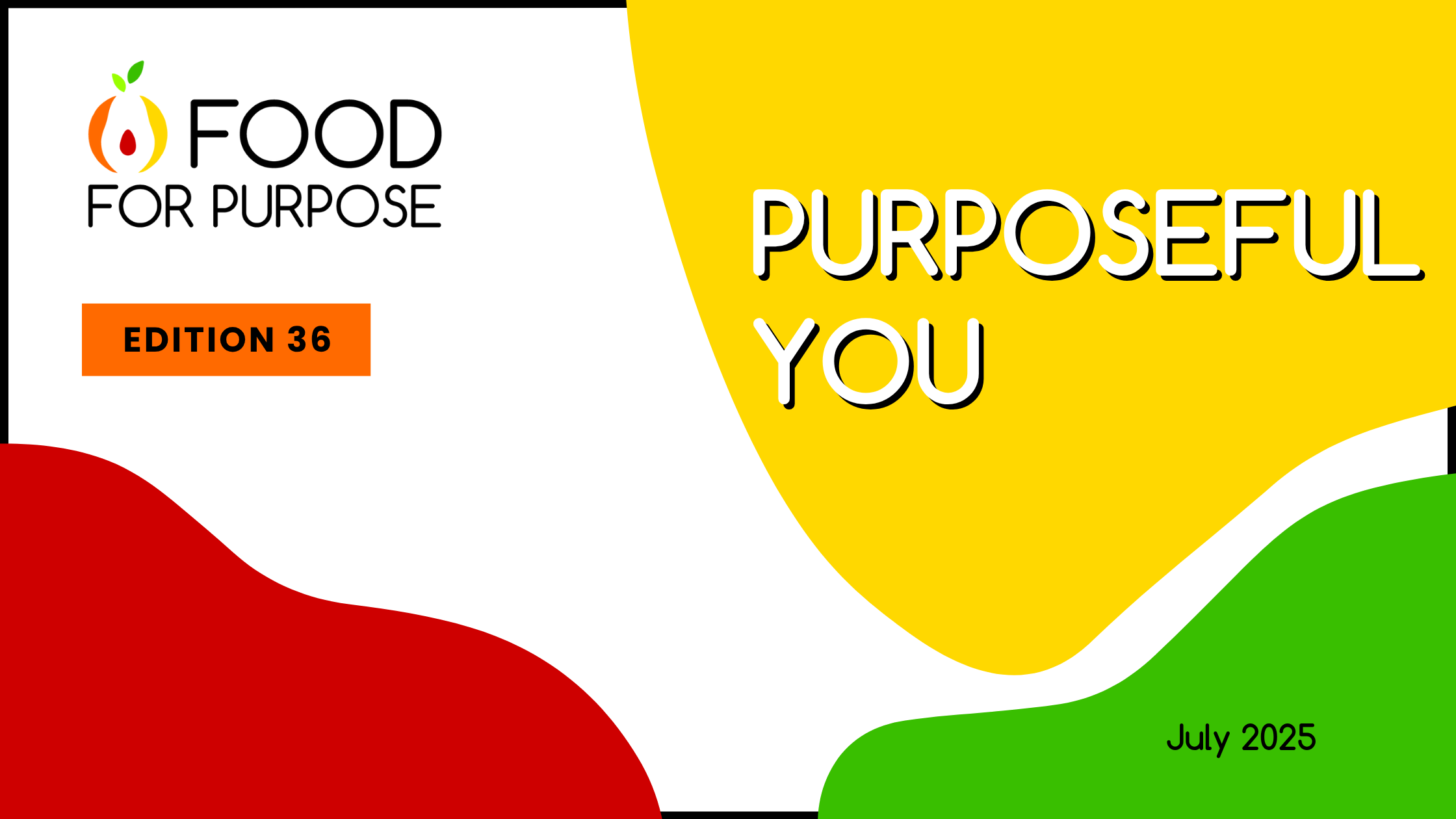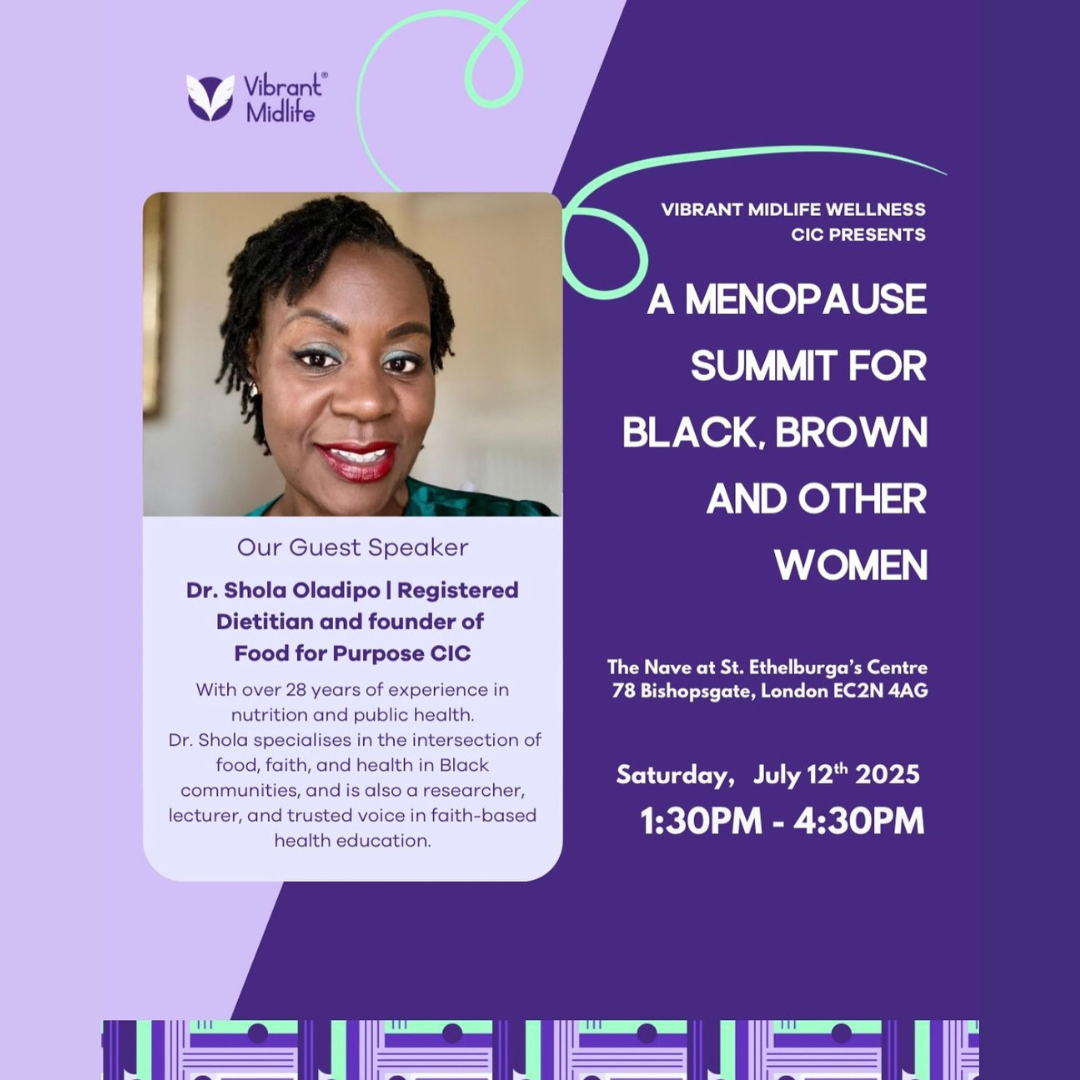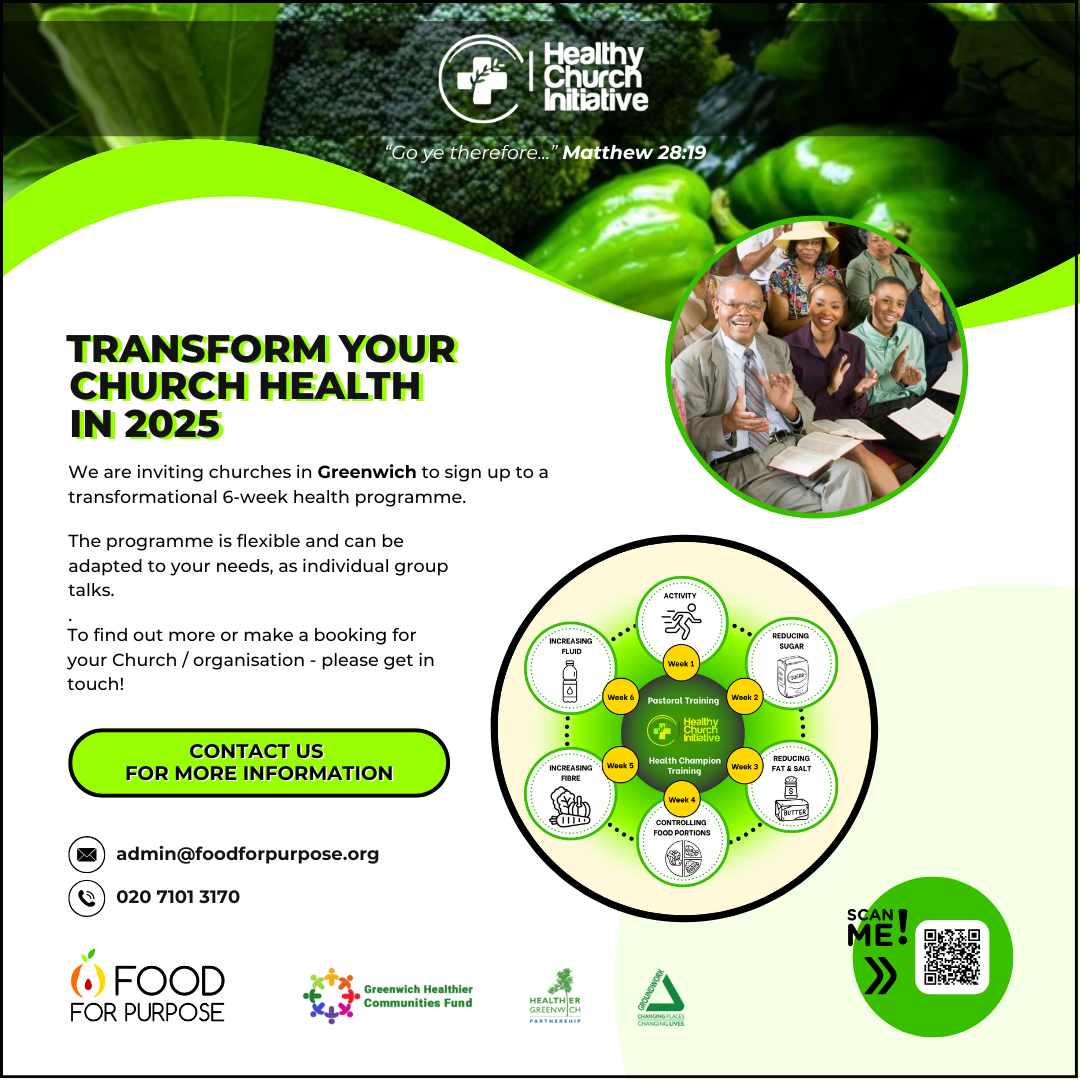Edition 36
July 2025
Nourishing Your Future Self: The Ripple Effect of Daily Wellness
By Shola Oladipo, Food for Purpose CEO
Hello, dear PY friends,
This month, I've been reflecting on how our daily choices profoundly impact our long-term well-being. Nothing really happens in isolation, everything affects everything! Each decision, whether it’s opting for a balanced meal or setting aside time for mindfulness, becomes a valuable gift to our future selves. I hope this inspires you to view every health choice as a step toward a brighter future.
Every meal is an investment in the “you” of tomorrow. The choices we make today, not just what we eat, but also how we move, rest, and connect, create ripples that extend far beyond the present moment.
Have you considered that the nutrients from today’s meal choices are vital for rebuilding & renewing your cells in the weeks ahead. The walk you take this afternoon will not only strengthen your body but also enhance your resilience against future stress. The mindful moments you prioritise today support a solid foundation for clearer thinking and emotional balance in the years to come.
True health isn’t merely about avoiding illness; it’s about cultivating vitality that compounds over time. Nourishing our bodies with whole foods, prioritising restorative sleep, and tending to our mental well-being means we’re not just feeling better today. We’re also reducing inflammation, supporting brain health, and building the energy reserves that will carry us through life’s challenges.
There is hope in knowing that small, consistent choices can lead to profound change. Your older self will thank you for the seeds of health you plant today. Start where you are, with what you have.
Your future is listening.
Blessings!
Shola
CEO Says - Nourishing Your Future Self: The Ripple Effect of Daily Wellness
HCI News - The Healthy Church Initiative Is In Greenwich!
Physical Activity Tips - Impostor Syndrome in the Gym: Feeling Unfit in Fit Spaces
Recipe of the Month - Locust Bean Stew (Obe Iru or Obe Ata Iru)
A-Z of Soul Food - Iru
Diabetes Tips - Understanding Prediabetes and Reducing Risks: Part 1
Let’s Talk - Sit-Up and Smell the Science
Real Topics, Real Talk - Faith, Health and Purpose
✨ In case you missed it! ✨
Last month, our amazing CEO, joined the brilliant ‘Real Topics, Real Talk’ show live on Chalkhill Community Radio for an inspiring and honest conversation.
She shared her expert insights as a dietitian, diving into all things health, food, and purpose, a truly uplifting and powerful chat you’ll want to hear.
🎧 Missed it live? No worries, click on the button below.
Vibrant Midlife Menopause Summit
Exciting news! On Saturday 12th July, our incredible CEO will be speaking at the Vibrant Life Menopause Summit!
She'll be sharing her expert insights on how to fuel your body through midlife, and will be answering your questions during the live Q&A.
It's one you won't want to miss!
Obesity Treatments
Based on current evidence, pharmacotherapy plays a crucial role in obesity treatment. The Association for the Study of obesity issued an important statement reminding us that drugs alone are not the answer and that a whole systems approach, with the prevention message being key, is still the way forward.
See below:
Our Cooking sessions - 100% satisfaction!
To date, our cooking sessions have supported over 100 patients living with chronic illnesses. Evaluations show participants enjoy the culturally tailored recipes, expert advice from our team, and exploring the new flavours, whilst respecting our rich cultural heritage from Africa and the Caribbean.
One participant at a type 2 DIabetes session (HEAL-D) said:
“This will benefit me in the long run, by excluding all the salt and adding more herbs and natural spices…”
National Days / Weeks / Month - July 2025
5th July - NHS birthday
7th-13th July - Alcohol Awareness Week
18th July - Black Leaders Awareness Day
The Healthy Church Initiative Is In Greenwich!
Are you ready to transform the health and wellbeing of your congregation this year? The Healthy Church Initiative (HCI) is a unique, faith-based health programme designed specifically for churches like yours in Greenwich, and it’s completely free to participate.
The HCI is a flexible, 6-week programme that brings practical health knowledge into your church in a way that is relatable, engaging, and grounded in biblical wisdom. Whether you’re a small fellowship or a large ministry, the sessions can be tailored to meet your needs.
Churches that have already taken part describe the programme as interactive, informative, and truly transformative. Participants not only learn how to improve their physical health, but also reflect on what it means to honour God by caring for their bodies.
“I am more aware of how I keep my body actively moving and ensuring that anything I consume contributes to developing a healthy body, to God’s honour and glory.”
We believe every church should be a hub of health, hope, and healing, and we’re here to support you in making that vision a reality.
Sign up today, it's free!
Get in touch to book your place or find out more:
📧 admin@foodforpurpose.org
📞020 7101 3170
Impostor Syndrome in the Gym: Feeling Unfit in Fit Spaces
By Precious Oladipo
FFP Director & Physical Activity Lead
Ever walk into a gym and feel like you accidentally crashed a fitness influencer’s private party? Maybe you're new to working out, maybe you're just getting back into it, or maybe you still feel out of place even after months of showing up. You're not alone, and you're definitely not imagining it.
This feeling has a name: impostor syndrome. It’s that voice in your head saying, “Everyone here knows what they’re doing. I don’t belong.” It’s common, especially in spaces where fitness seems to have a one-size-fits-all look, sculpted, confident, and already fit.
But here’s the truth: every single person started somewhere. That person squatting double their body weight? They were once a beginner too. Everyone has felt awkward, unsure, or out of sync at some point.
There’s no “fitness level” you need to achieve before you’re allowed to take up space. You’re already doing the hard part, showing up. Whether you're walking the treadmill, lifting soup cans at home, or trying your first group class, it all counts.
So next time that impostor voice pipes up, remind yourself: you belong in every space you step into, sweaty and all.
Still unsure? Bring a friend, go during quieter hours, or throw on some music and fake confidence until it sticks. (Pro tip: it usually does.)
You’ve got this. Really.
Locust Bean Stew (Obe Iru or Obe Ata Iru)
This month, we are showcasing one of the many dishes where ‘iru’, our A-Z spice of the month, can be used. Locust beans stew is a popular traditional dish among the Yoruba communities in the western part of Nigeria (West Africa). It is a stew that can be enjoyed with many carbohydrate staples such as yam, rice, and plantain (except swallows). Generally, fresh whole locust beans (iru) are used to make this stew. It is a very spicy dish; however, we have prepared ours with only two scotch bonnets for a medium to mild heat. We hope you enjoy having a go at making the stew!
Let’s get cooking!
Serves 4-6
Preparation time: 45-60 minutes (including cooking time for meat
Cook time: 40-45 minutes
Total time: about 1 hour and 45 minutes
Ingredients
4 medium-sized red bell peppers, cleaned and chopped
2 scotch bonnets
1 large onion, chopped
200ml palm oil
3 gloves garlic
2 teaspoons ginger, chopped
4 tablespoons locust beans (iru)
450g assorted cooked meat (goat, beef, tripe), cut into bite-sized portions
3 tablespoons ground crayfish
1 whole smoked mackerel fish, deboned and shredded
4 boiled eggs
Salt to taste
Method
Blend the bell peppers, half of the chopped onion, and scotch bonnets in a food processor until you achieve a coarse consistency. Don't over-blend - you want some texture.
In a large saucepan, heat the palm oil over medium heat for about 1 minute.
Add the remaining chopped onions, minced garlic, and ginger to the oil. Sauté for 1-2 minutes until fragrant.
Stir in half of the locust beans and cook for 2 minutes, allowing them to release their flavour and add the pepper mix and leave to cook for about 10 minutes.
Add half the locust beans, cook for 2 minutes, then add the pepper mix, stir and leave to cook for about 10 minutes
Add the assorted cooked meat and ground crayfish. Mix thoroughly and cook for 15 minutes, stirring at regular intervals to ensure even cooking and prevent burning.
Add the remaining locust beans and shredded fish and cook for 10 minutes
Carefully add the boiled eggs to the stew and cook for 2 minutes to warm through. Season with salt to taste.
Your stew is ready to serve! Enjoy!
Tips:
You can use extra scotch bonnets if you prefer extra heat
We used less oil in our recipe, so make sure to remove any excess oil from the top of the cooked stew.
Recipe courtesy of:
https://sisijemimah.com/2017/08/11/locust-beans-stew-obe-ata-iru/
https://kscuisine.com/locust-beans-stew-obe-iru-or-obe-oniru/
Image courtesy of: www.sisijemimah.com
Iru
This month, we’re celebrating Iru for the letter I!
Iru also known as locust beans are the fermented seeds of the African locust bean. They have a long history of cultivation in West Africa, especially in Nigeria, Ghana, and Burkina Faso. It is a common spice that adds flavour to many meals in West Africa. It is commonly called Iru (Yoruba), ogiri (Igbo), dawadawa (Hausa), or soumbala (Benin). It has a very strong, pungent aroma and is available in both fresh and dried forms, either whole or ground. It is used extensively to flavour many traditional stews and soups.
Nutritionally, iru:
Is rich in protein, hence a great alternative to animal protein for muscle growth and repair
Is rich in fibre to support healthy gut health
Is rich in antioxidants, protecting the body against free radicals
Contains calcium, potassium, iron, phosphorus, manganese, and B vitamins
Where to find iru in the UK
Iru can be purchased from African grocery stores. They are usually frozen, but dried powder versions are now readily available.
Understanding Prediabetes and Reducing Risks: Part 1
By Modupe Peters
FFP Director & Diabetes Lead
Diabetes is a growing concern in the UK and worldwide, with the number of people diagnosed with type 2 diabetes continuing to rise. Last month marked Diabetes Awareness Week (9th-16th June), a week aimed at raising awareness about diabetes in the UK. In this article, we'll explore the risk factors for developing type 2 diabetes and ways to reduce the risk.
What is prediabetes?
Prediabetes serves as a warning for type 2 diabetes. Blood sugar levels are higher than normal but not high enough for a diagnosis of type 2 diabetes. Someone with prediabetes has a greater risk of developing the condition.
In the UK, an estimated 6.3 million people are at increased risk of type 2 diabetes based on their blood sugar levels. It is also believed that 1.3 million people are currently living with diabetes without knowing it.
Who is at risk?
People with the following risk factors are at a greater risk of developing type 2 diabetes:
Being overweight or obese, especially around the waist (central/abdominal fat – high waist circumference), is strongly linked to insulin resistance.
People of South Asian, Black African, and African-Caribbean descent are 2 to 4 times more likely to have type 2 diabetes.
Age is another factor, with people of African-Caribbean, Black African, or South Asian descent typically developing symptoms over 25, compared to around age 40 for the Caucasian population.
You're also more at risk if you've ever had high blood pressure.
You're more likely to develop type 2 diabetes if one or more of these risk factors apply to you. We'll be looking at ways to lower your risk in part 2, so do join us next month!
Sit-Up and Smell the Science
We all know that person, you know, the one doing 300 sit-ups a day and swearing their belly fat is on the brink of disappearing?
It’s admirable... kind of. But let’s be honest, we’ve all fallen into that trap at some point. You do a few too many crunches, start to feel the burn, and think, “Yep, my abs are probably peeking through now.” Next thing you know, your neck is sore, your hip flexors are overworked, and your stomach? Still chilling under a nice, comfy layer of... well, yesterday’s snacks.
Here’s the truth: you cannot crunch your way to a flat stomach. If that were the case, we’d all have abs just from lying down and trying.
Core workouts though? Great! Keep doing them, they’re fantastic for posture, strength, and overall stability. But if you're on a mission to lose belly fat, you’ll need more than just crunches. Add some cardio, eat a balanced diet, and drink enough water to make your houseplants jealous.
Abs are made in the kitchen, revealed through movement, and protected by not overworking yourself into A&E. Let’s not fight biology on this one!

Let's keep in touch
For general enquiries about Food for Purpose:
For Newsletter enquiries / content suggestions:






























